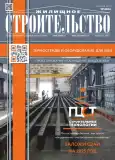An indicator of the uniformity of the distribution of the areas of green areas of common use
- Authors: Diachkova O.N.1, Mikhailov A.E.1, Bakaeva N.V.2
-
Affiliations:
- Saint-Petersburg Petersburg State University of Architecture and Civil Engineering
- National Research Moscow State University of Civil Engineering
- Issue: No 10 (2024)
- Pages: 67-71
- Section: Articles
- URL: https://ter-arkhiv.ru/0044-4472/article/view/641761
- DOI: https://doi.org/10.31659/0044-4472-2024-10-67-71
- ID: 641761
Cite item
Abstract
The developing sustainability of cities is closely linked to ensuring the balance of green areas of common use. It has been scientifically proven that the effects of green zones are significant for both the environment and the population. An urgent task of the territorial and spatial organization of the city and its administrative-territorial units is a strategic assessment of the uniformity of the distribution of green areas of common use.The working hypothesis is the assumption that using the Kulback–Leibler distance, it is possible to accurately describe the degree of unevenness of the distribution of the areas of green areas of public use relative to the areas of the administrative-territorial units of the city and the resident population. The areas of green spaces of common use and administrative-territorial units of the cities of Berlin, Moscow and St. Petersburg are studied. It was established that the distribution of the areas of the open public green spaces in Berlin is close to uniform, the distribution of the areas of the city’s territorial units is uneven, in Moscow it is the opposite, and in St. Petersburg the distribution of both the areas of open public green spaces and the districs are uneven. The indicator of uniformity of distribution of the areas of open public green spaces relative to the land management of the city, developed by the authors, calculated on the basis of a dimensionless value – the Kullback–Leibler distance, makes it possible to evaluate and compare the degree of unevenness of the distribution of the areas of open public green spaces relative to the areas of territorial units, in the territories of which they are located, both for the city and between cities. The indicator may be in demand at the stage of making management decisions to ensure total area of open public green spaces during urban planning of the city territory and its administrative-territorial units.
Full Text
About the authors
O. N. Diachkova
Saint-Petersburg Petersburg State University of Architecture and Civil Engineering
Author for correspondence.
Email: dyachkova_on@mail.ru
Candidate of Sciences (Engineering)
Russian Federation, 4, 2nd Krasnoarmeyskaya Street, Saint Petersburg 190005A. E. Mikhailov
Saint-Petersburg Petersburg State University of Architecture and Civil Engineering
Email: event_horizon@inbox.ru
Candidate of Sciences (Physics and Mathematics)
Russian Federation, 4, 2nd Krasnoarmeyskaya Street, Saint Petersburg 190005N. V. Bakaeva
National Research Moscow State University of Civil Engineering
Email: natbak@mail.ru
Doctor of Sciences (Engineering)
Russian Federation, 26, Yaroslavskoe Highway, Moscow, 129337References
- Vlasov D.N., Danilina N.V. Concepts of sustainable development of territories. Arkhitektura i stroitel’stvo Rossii. 2023. No. 2, pp. 8–9. (In Russian). https:// doi.org/10.55394/02357259_2023_2_8
- Yushkova N.G., Alekseev Yu.V. Improvement of coordination in the system territorial planning, urban zoning and territory planning references. Biosfernaya sovmestimost’: chelovek, region, tekhnologii. 2020. No. 3, pp. 36–53. (In Russian). https:// doi.org/10.21869/2311-1518-2020-31-3-36-53
- Tkachenko L.Ya., Ivashkina I.V., Kochurov B.I. The territorial planning ecologization of urbanized regions in Europe: The best foreign practices. Ecology of urban areas. 2023. No. 4, pp. 99–109. (In Russian). https://doi.org/10.24412/1816-1863-2023-4-99-109
- Dembich A.A. Agglomerations of Tatarstan – spontaneous formation or planned development. Arkhitektura i stroitel’stvo Rossii. 2022. No. 2, pp. 20–25. (In Russian).
- Kondo M., Fluehr J., McKeon T., Branas, C. Urban green space and its impact on human health. International Journal of Environmental Research and Public Health. 2018. No. 15 (3), pp. 445. https:// doi.org/10.3390/ijerph15030445
- Grabowski Z.J., McPhearson T., Pickett S.T.A. Transforming US urban green infrastructure planning to address equity. Landscape and Urban Planning. 2023. No. 229, pp. 104591. https://doi.org/10.1016/j.landurbplan.2022.104591
- Wolff M., Dagmar H. Mediating sustainability and liveability – turning points of green space supply in European cities. Frontiers in environmental science. 2019. Vol. 7, pp. 61. https://doi.org/10.3389/fenvs.2019.00061
- Danilina N.V., Majorzadehzahiri A. Analysis situation of urban green space framework in Tehran. Vestnik MGSU. 2021. Vol. 16, Iss. 8, pp. 975–985. (In Russian). https://doi.org/10.22227/1997-0935.2021.8.975-985
- D’yachkova O.N., Mikhailov A.E. Green public spaces in Berlin. Traditions and innovations in construction and architecture. Architecture and urban planning: Collection of articles of the 81st All-Russian scientific and technical conference. Samara. 2024, pp. 370–376. (In Russian).
- D’yachkova O.N., Mikhailov A.E. Empirical distribution functions is mathematical method for talk about urban planning. Ekologiya urbanizirovannykh territorii. 2023. No. 2, pp. 61–71. (In Russian). https:// doi.org/10.24412/1816-1863-2023-2-61-71
- D’yachkova O.N., Mikhailov A.E. Open public green spaces in Moscow: distribution of areas. Sustainable development of territories: Collection of reports of the VI International scientific and practical conference. Moscow. 2024, pp. 10–15. (In Russian).
Supplementary files






